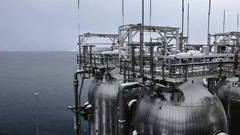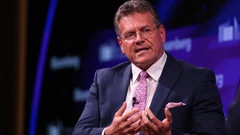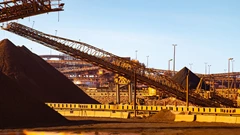Europe Braces for Tense Countdown to Ukraine Gas Flow Halt
(Bloomberg) -- With less than two weeks left until a transit deal between Russia and Ukraine expires, Europe’s natural gas market is getting ready for turbulent trading after the New Year break. Instead of partying on Dec. 31, traders will be refreshing their screens to check headlines and grid data for clues on a last-minute solution — if there is one.
Major banks and the European Commission are preparing for pipeline flows across Ukraine to come to a stop on Jan. 1, forcing the continent to turn to other sources to replace them and likely driving up prices. Russia delivers about 15% of Europe’s gas imports, and while only a third of that goes through Ukraine, traders remain on high alert.
The current deal governing pipeline flows won’t be renewed, and Ukraine tempered hopes this week for many of the other potential workarounds that had been floated by central European countries which still rely on the fuel. President Volodymyr Zelenskiy doesn’t want any gas of Russian origin to transit his country unless Moscow isn’t paid until the war ends, leading to frictions in last-minute discussions and market volatility as traders try to guess the implications.
“If Ukraine is not prepared to accommodate intermediaries to continue flows, it makes a deal almost impossible,” said Massimo Di Odoardo, vice president for gas and liquefied natural gas research at Wood Mackenzie Ltd.
First Scenario: No Deal
The Commission is preparing for flows to be halted, which is also the base-case scenario at banks including Goldman Sachs Group Inc., Morgan Stanley, JPMorgan Chase & Co. and HSBC Holdings Plc. The lost volumes would particularly hurt countries such as Slovakia, which has been pushing for a deal in recent weeks, warning over possible financial damage.
Yet Zelenskiy dismissed those concerns on Thursday, saying it’s “a bit shameful to talk about money because we are losing people.” Some of the flows in question also go to Austria, Czech Republic and Italy, and the search for new supplies could drive up regional prices in the short term.
“While this volume is not very significant to Europe as a whole, it is certainly important for several individual EU member states,” said Katja Yafimava, a senior research fellow at the Oxford Institute for Energy Studies, in a report.

A recent assessment carried out by the EU’s executive arm said the overall impact should be “negligible,” however, since the bloc has other sources. The 15 billion cubic meters of gas that Russia currently sends through Ukraine per year make up less than 5% of Europe’s overall needs. Russia could boost some of the volumes it sends through other routes, such as LNG tankers and pipelines to Turkey, though the spare capacity is limited.
“The price rise will only be significant for a few days in the new year before the market gets accustomed to the new normal and prices will stabilize again,” said Florence Schmit, a European energy strategist at Rabobank.
Second Scenario: Delayed Deal
There are hopes that a solution might be found, albeit not by Jan. 1 and possibly with reduced flows.
The talks are complicated. Ukraine has insisted it doesn’t want to transport Russian gas through its pipelines and won’t support alternative solutions that still fund Russia’s war. Many of the options that seemed plausible a week ago may be off the table now.
If there is a country “ready to give us the gas but not pay the money back to Russia until the end of the war, then it’s a possible potentiality, we can think about it,” Zelenskiy said.

“Negotiations are obviously very complex, there’s a lot of politics and many different interests to navigate — so it’s very difficult to predict what will happen on Jan. 1,” said Marco Saalfrank, head of continental Europe merchant trading at Swiss utility Axpo Solutions AG.
Some gas traders have also speculated that a deal will become more likely after US President-elect Donald Trump is inaugurated on Jan. 20. Throughout his campaign, Trump stated he would prioritize initiating Ukraine-Russia peace talks. But the US is one of Europe’s top gas suppliers and has its own ambitions in the region. On Friday, he threatened to slap tariffs on EU exports if member states don’t buy more American oil and gas.
Third Scenario: Deal by Dec. 31
A rushed agreement would come as a surprise to most market participants who have watched talks drag on for months and spark at least a temporary selloff. Should any deal still materialize, it would require intense efforts to find a solution that would be acceptable for Ukraine.
Speculators have recently boosted their bullish bets to a record before paring them back, creating potential for abrupt price moves if there is a deal. But any price drop would likely be brief, as global gas markets remain tight and Europe still has to compete for LNG cargoes with other global buyers.
At the end of the day “the only certainty is that Europe needs more gas,” said Francisco Blanch, commodity strategist at Bank of America Corp.
(Updates with latest developments throughout.)
©2024 Bloomberg L.P.
KEEPING THE ENERGY INDUSTRY CONNECTED
Subscribe to our newsletter and get the best of Energy Connects directly to your inbox each week.
By subscribing, you agree to the processing of your personal data by dmg events as described in the Privacy Policy.
More gas & LNG news

ADNOC successfully completes $2.84 billion marketed offering of ADNOC Gas shares

Scientists Say EU Carbon Market Should Include Removals Like CCS

Trump Will Allow for More Gas Pipe Expansion, Southern CEO Says

EU Trade Chief Says Ready to Work With US on Lower Tariffs

EU to Look at More ‘Flexible’ Filling of Gas Storage Post-2025

bp begins production from Raven Phase 2, offshore Egypt

Diamondback Nears Permian Deal to Buy Shale Producer Double Eagle

Australia’s Iron Ore Hub Reopens, Rio Mines Resume After Cyclone

Australia’s Iron Ore Export Hub to Reopen After Cyclone Weakens
















